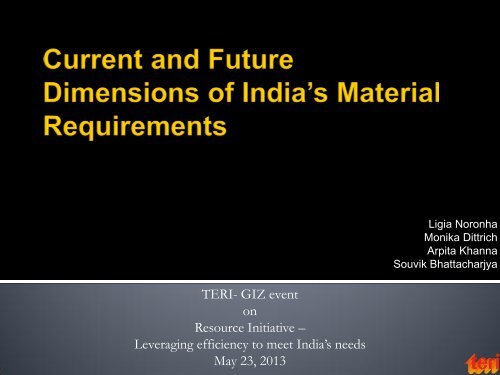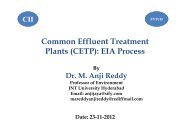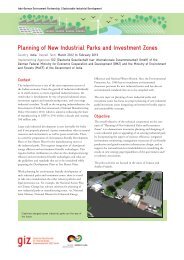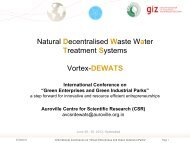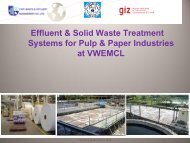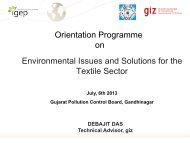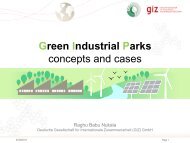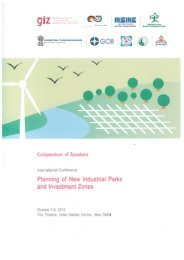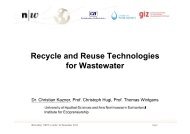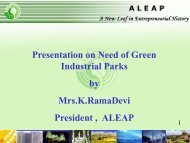Current and Future Dimensions of India's Material ... - IGEP.in
Current and Future Dimensions of India's Material ... - IGEP.in
Current and Future Dimensions of India's Material ... - IGEP.in
Create successful ePaper yourself
Turn your PDF publications into a flip-book with our unique Google optimized e-Paper software.
TERI- GIZ event<br />
on<br />
Resource Initiative –<br />
Leverag<strong>in</strong>g efficiency to meet India’s needs<br />
May 23, 2013<br />
Ligia Noronha<br />
Monika Dittrich<br />
Arpita Khanna<br />
Souvik Bhattacharjya
Dittrich, Giljum, Lutter, Polz<strong>in</strong>, 2012: Green economies around the world: Implications <strong>of</strong> resource use for development <strong>and</strong> the<br />
environment, Vienna. Page50.
India<br />
Germany<br />
Ch<strong>in</strong>a<br />
Average material consumption per capita <strong>in</strong> 2008<br />
Averages World India Ch<strong>in</strong>a S. Korea Japan Germany OECD<br />
Biomass 2.8 1.7 2.2 1.5 1.2 2.3 3.7<br />
Nonmetal<br />
M<strong>in</strong>erals<br />
Fossil<br />
fuels<br />
4.5 1.4 8.5 8.7 4.3 6.8 9.4<br />
1.9 0.7 2.3 4.4 3.8 5.2 4.9<br />
Metals 1.0 0.2 1.2 1.1 0.8 0.5 1.4<br />
total 10.2 4.0 14.2 15.8 10.2 14.8 19.4<br />
• Own calculation based on Dittrich, 2012 (trade), SERI, 2011<br />
(extraction), Worldbank, 2011 (population)
Dittrich, Giljum, Lutter, Polz<strong>in</strong>, 2012: Green economies around the world: Implications <strong>of</strong> resource use for development <strong>and</strong> the<br />
environment, Vienna. Page 29
http://www.earth-policy.org/Updates/Update45_data.htm<br />
Advertis<strong>in</strong>g, <strong>and</strong><br />
the narrative <strong>of</strong> the<br />
“good life”<br />
<strong>Material</strong><br />
Dem<strong>and</strong><br />
Drivers<br />
Data Source:<br />
McK<strong>in</strong>sey & Company,<br />
2010<br />
Rapid Urbanization: Rate <strong>of</strong> urbanization<br />
has <strong>in</strong>creased from 26% <strong>in</strong> 1991 to 30% <strong>in</strong><br />
2008. It is further expected to <strong>in</strong>crease to<br />
40% by 2030 (McK<strong>in</strong>sey 2010)<br />
Source: JNNURM Directorate, M<strong>in</strong>istry <strong>of</strong> Urban Development <strong>and</strong> National<br />
Institute <strong>of</strong> Urban Affairs (NIUA), 2011
Absolute biomass consumption<br />
Biomass consumption per capita<br />
In 2008,<br />
17% <strong>of</strong> global population live <strong>in</strong> India<br />
10.5% <strong>of</strong> global biomass extraction is consumed <strong>in</strong> India<br />
Per-capita-consumption biomass, India‘s place <strong>in</strong> world is 147<br />
• Own calculation based on Dittrich, 2012 (trade), SERI, 2011<br />
(extraction), Worldbank, 2011 (population)
• Own calculation based on Dittrich, 2012 (trade),<br />
SERI, 2011 (extraction), Worldbank, 2011<br />
0.1% phosphate rock<br />
8% limestone<br />
87% construction m<strong>in</strong>erals,<br />
On the whole, India is<br />
currently selfsufficient<br />
with regard<br />
to m<strong>in</strong>erals<br />
India is a net-importer, <strong>in</strong><br />
fertilizers, limestone<br />
<strong>and</strong> several <strong>in</strong>organic<br />
chemicals such as<br />
phosphorous pent<br />
oxides<br />
Import dependencies <strong>in</strong><br />
phosphates are high<br />
with 93% net-imports<br />
<strong>in</strong> consumption while<br />
it is low <strong>in</strong> limestone<br />
(2% net-imports<br />
consumption)<br />
In 2008,<br />
- India consumes 5% <strong>of</strong> globally extracted<br />
m<strong>in</strong>erals<br />
- per capita consumption <strong>of</strong> m<strong>in</strong>erals, place<br />
125 <strong>in</strong> world<br />
- Average growth rate: +26% p.a.
• Own calculation based on Dittrich, 2012 (trade), SERI, 2011<br />
(extraction), Worldbank, 2011 (population)<br />
In 2008,<br />
5.9 % <strong>of</strong> global fossil fuels extraction is consumed <strong>in</strong> India<br />
Per-capita-consumption <strong>of</strong> fossil fuels, India‘s place <strong>in</strong> world is 100<br />
Average growth rate: +15% p.a.
Av. growth +26% p.a.<br />
Av. growth +15% p.a.<br />
In 2008, India „consumes“ 3.2% <strong>of</strong> global metal extraction<br />
In per capita-values, India‘s „consumption“ ranges on place 108 <strong>in</strong> 2008<br />
• Extraction: SERI, 2011; trade: Dittrich, 2012; population: Worldbank,<br />
2011
<strong>Future</strong> dem<strong>and</strong> <strong>in</strong> India, all materials<br />
Increase <strong>in</strong> material dem<strong>and</strong><br />
until 2030 is about 2.5 to 3<br />
fold, beyond that it is 4 to 5<br />
fold<br />
GOI data bases, <strong>Material</strong> specific projections<br />
MFA based projections
• Domestic resources<br />
• 97 % <strong>of</strong> all materials, consumed <strong>in</strong> India are<br />
extracted with<strong>in</strong> India.<br />
▪ However, meet<strong>in</strong>g a tripl<strong>in</strong>g dem<strong>and</strong> with domestic<br />
resources would mean that extraction has to <strong>in</strong>crease<br />
from currently around 4.5 billion tonnes up to more<br />
than 13 billion tonnes.<br />
• <strong>Material</strong>s are imported<br />
▪ India net imports around 3 % <strong>of</strong> all materials<br />
consumed. Meet<strong>in</strong>g the <strong>in</strong>creas<strong>in</strong>g material dem<strong>and</strong><br />
by imports raises severe issues <strong>of</strong> global availability
• India’s m<strong>in</strong><strong>in</strong>g sector has one <strong>of</strong> the lowest<br />
exploration spends (MoM 2011).<br />
• The reserves for iron ore <strong>and</strong> bauxite <strong>in</strong><br />
Australia grew 150 to 200% between 1985<br />
<strong>and</strong> 2005. In contrast, <strong>in</strong> India they<br />
<strong>in</strong>creased by 10-20% only<br />
Source: Strategic plan, M<strong>in</strong>istry <strong>of</strong> M<strong>in</strong>es, Government <strong>of</strong> India
Metallic m<strong>in</strong>erals<br />
20000<br />
0<br />
17882<br />
Iron ore<br />
5982<br />
208<br />
India’s (unrealized)<br />
m<strong>in</strong>eral potential<br />
(<strong>in</strong> million tonnes)<br />
Industrial m<strong>in</strong>erals<br />
60000<br />
40000<br />
20000<br />
40906<br />
Lignite<br />
6145 38<br />
800 Manganese, Lead & Z<strong>in</strong>c, Chromite 685<br />
600<br />
400<br />
200<br />
0<br />
203<br />
32<br />
430<br />
97 109<br />
4 3 7<br />
Chromite Manganese Lead & Z<strong>in</strong>c<br />
Resources Reserves Production<br />
Bauxite ()<br />
350<br />
300<br />
250<br />
200<br />
150<br />
100<br />
50<br />
0<br />
335<br />
296<br />
270<br />
103<br />
83<br />
55 67 73<br />
30<br />
0.5 21<br />
35<br />
1 1 2 0.05 0.2 2<br />
0<br />
Resources Reserves Production<br />
Coal<br />
293497<br />
300000<br />
200000<br />
118145<br />
100000<br />
533<br />
0<br />
Resources Reserves Production<br />
Petroleum<br />
4000<br />
3000<br />
3480<br />
1000<br />
757<br />
2000<br />
1000<br />
593<br />
13<br />
Resources Reserves Production<br />
500<br />
38<br />
0<br />
Resources Reserves Production<br />
Source: M<strong>in</strong>erals Yearbook 2011, Indian Bureau <strong>of</strong>Mi<strong>in</strong>es<br />
0<br />
Reserves<br />
Production
Increas<strong>in</strong>g constra<strong>in</strong>ts <strong>in</strong> social<br />
license to operate<br />
MMDR bill adresses<br />
some <strong>of</strong> these<br />
constra<strong>in</strong>ts<br />
Source: CSE<br />
14
Source: IBM 2011, M<strong>in</strong>istry <strong>of</strong><br />
m<strong>in</strong>es<br />
<br />
<br />
<br />
Import dependency is projected to <strong>in</strong>crease to 90-93% for oil, 11-45% for coal by<br />
2031<br />
High anticipated domestic dem<strong>and</strong> comb<strong>in</strong>ed with <strong>in</strong>adequate production will<br />
<strong>in</strong>crease import dependency for various m<strong>in</strong>erals & metals.<br />
Copper imports, for <strong>in</strong>stance, are expected to <strong>in</strong>crease 5 fold between 2009 <strong>and</strong>
Source: IMF data, WEO 2012, p 125
• At the height <strong>of</strong> the oil prices <strong>in</strong> July 2008, for example, the cost<br />
<strong>of</strong> import<strong>in</strong>g oil was almost 50% <strong>of</strong> its commodity exports; <strong>and</strong><br />
about 6% <strong>of</strong> GDP;<br />
• As per estimates <strong>of</strong> the International Energy Agency (IEA), a<br />
susta<strong>in</strong>ed $ 10/bbl oil-price <strong>in</strong>crease will result <strong>in</strong> a loss <strong>of</strong> 1% <strong>of</strong><br />
India’s GDP <strong>and</strong> 2.6% <strong>in</strong>crease <strong>in</strong> <strong>in</strong>flation <strong>in</strong> the follow<strong>in</strong>g year<br />
<strong>of</strong> the price <strong>in</strong>crease<br />
• In 2031, Energy import bill is expected to constitute a large<br />
share <strong>of</strong> GDP (TERI: ~17% <strong>of</strong> GDP);<br />
• High oil prices impact the poor disproportionately as costs <strong>of</strong><br />
food, transport rise steeply<br />
• Economic risks to India exist both due to oil <strong>and</strong> metals<br />
dependence, but <strong>in</strong> case <strong>of</strong> metals, political risks may be higher.
Concentration <strong>in</strong> production & reserves<br />
Concentration at country level<br />
Source: DEFRA <strong>and</strong> BIS (2012<br />
Source: OECD (2010)<br />
Concentration at company level<br />
Metals<br />
Share <strong>of</strong><br />
world<br />
producti<br />
on Country M<strong>in</strong><strong>in</strong>g company<br />
Antimon<br />
y 82-87% Ch<strong>in</strong>a<br />
Hsikwangshan Tw<strong>in</strong>kl<strong>in</strong>g<br />
Star<br />
Berylliu<br />
m 81-90% USA Brush Wellman (Delta)<br />
Palladiu<br />
m 45-65% Russia Norilsk<br />
Plat<strong>in</strong>um 77-80%<br />
South<br />
Africa<br />
Amplats-Implats-Lonn<strong>in</strong><br />
(Bushveld)<br />
Lithium 60-80% Chile<br />
Sociedad Quimica y M<strong>in</strong>era<br />
de chile SA- Soquimich<br />
(Salar d' Atacama)<br />
Niobium 90% Brazil<br />
Companhia Brasileira de<br />
Metallurgia e m<strong>in</strong>eracao<br />
CBMM (Araxa)<br />
Rare<br />
earths 85-95% Ch<strong>in</strong>a<br />
Baotou Iron & Steel<br />
Company<br />
Tantalu<br />
m 60-70% Australia Sons <strong>of</strong> Gwalia<br />
Tungste<br />
n 75-84% Ch<strong>in</strong>a Jianxi Tungsten
• Use <strong>of</strong> reserve base for atta<strong>in</strong><strong>in</strong>g political objectives:<br />
• For <strong>in</strong>stance, Ch<strong>in</strong>a’s recent ban on exports <strong>of</strong> rare earths. The<br />
strategic control led to an <strong>in</strong>crease <strong>in</strong> its price by approx. 300-700%<br />
(US DoE 2010)<br />
• Trade measures <strong>in</strong> resource-rich economies:<br />
• Proliferation <strong>of</strong> trade distort<strong>in</strong>g measures. Ukra<strong>in</strong>e, Argent<strong>in</strong>a,<br />
Ch<strong>in</strong>a, Russia, <strong>and</strong> Tanzania are among the key countries <strong>in</strong><br />
apply<strong>in</strong>g such measures.<br />
Grow<strong>in</strong>g Conflicts <strong>in</strong> m<strong>in</strong>eral rich countries
• What materials can be <strong>in</strong> short supply beyond 2030?<br />
• How well placed are we with regard to the materials needed for a more<br />
susta<strong>in</strong>able way <strong>of</strong> life, e.g., renewable energy?<br />
• Does India need to th<strong>in</strong>k about resource efficiency given its current low<br />
consumption rates per capita but grow<strong>in</strong>g water , environmental <strong>and</strong> l<strong>and</strong><br />
stresses?<br />
• How much can we reduce the environmental <strong>and</strong> social footpr<strong>in</strong>t through<br />
enhanced resource efficiency?<br />
• What other transformations are required to ensure that the economy <strong>of</strong><br />
resources so achieved does not result <strong>in</strong> an <strong>in</strong>crease <strong>in</strong> absolute<br />
consumption as warned by Jevons <strong>in</strong> his sem<strong>in</strong>al book The coal<br />
question?


